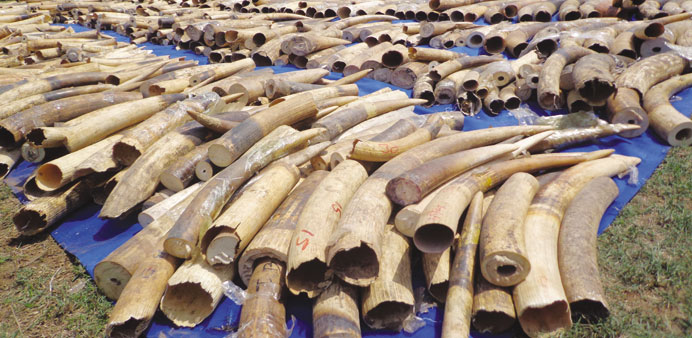This file picture taken on February 4 shows a stock of seized recently at Lome’s autonomous port, as it is displayed at the security ministry in Lome. Togo is intensifying its efforts to crack down on ivory trafficking after a number of large seizures, warning smugglers that the country will no longer be a staging post for the illegal trade.
Reuters/Geneva
More than 20,000 African elephants were killed for their ivory in 2013, driven by demand in China and Thailand, and some local populations face an immediate threat of extinction, a UN-linked wildlife conservation agency said yesterday.
Criminal gangs and rebel militias hunt dwindling herds for tusks that fetch many thousands of dollars per kilo, the Convention on International Trade in Endangered Species (CITES) said.
“Today we are confronting a situation of industrial-scale poaching and smuggling, the involvement of organised transnational criminal organisations, the involvement of rebel militia,” CITES secretary general John Scanlon told a briefing.
Fighters of the Lord’s Resistance Army (LRA) were sanctioned by the Security Council this year for illegal hunting and ivory trade, particularly in central Africa, he said.
The 2013 estimated figure is less than the peak of 25,000 elephants poached in 2011. But it was the third straight year that more than 20,000 were killed illegally on the continent that has an estimated 500,000 elephants left, according to CITES which monitors 51 sites, including national parks.
“It (poaching) is levelling off, but at a level that is far too high. The number of elephants that are killed is far exceeding the number of elephants being born,” Scanlon said.
Large seizures of smuggled ivory in Africa, those over 500 kilos, rose in 2013, for the first time exceeding those in Asia, according to CITES.
Its 1975 pact to ban or restrict trade in endangered species has been ratified by 180 countries.
A record 40,000kg were confiscated last year, already exceeded by an estimated 55,000kg seized this year, it said.
This was due to better enforcement especially in Uganda, Tanzania and Kenya, which accounted for 80 percent of the large-scale seizures in Africa last year, Scanlon said.
“We need to deploy the same sort of techniques that are deployed to combat other serious crimes such as illicit trade in narcotics, human trafficking or illicit trade in arms,” he said.
Rangers, custom officials and prosecutors must tackle poaching, driven by speculators betting on extinction, he said.
In January, China did its first crushing of confiscated ivory, destroying 6.2 tonnes in Dongguan, and Hong Kong is incinerating 28 tonnes, Scanlon said, calling it “a very strong signal”.
“It is crucial that we follow up after seizures with investigations so that we can address the entire crime chain right up to the receiver and the kingpin behind this illegal trade,” said Ben Janse van Rensburg, CITES enforcement officer.
China and Kenya, which deploys an elite anti-poaching unit at border points, co-operated closely to target an ivory smuggling syndicate operating between the two states, he said.
“This collaboration resulted in the arrest of two Chinese nationals in Kenya which was followed by an extradition to China in early 2014,” said Janse van Rensburg.
Poachers use sophisticated methods, said Tom de Meulenaer, CITES senior scientific officer. “Elephants are very difficult to hunt. That is why they resort to techniques such as poisoning, night goggles and helicopters.”
Southern Africa is home to nearly 55% of Africa’s known elephants, East Africa has 28% and Central Africa 16%, while West Africa has virtually none, CITES said.
Poaching is worst in central Africa, which has lost at least 60% of its elephants in the past decade, de Meulenaer said. “If this same trend continues in the next 10 years we may lose practically all of the elephants in central Africa.”
CITES hosts a meeting from July 7 to 11 to assess progress in eight countries identified last year as the most heavily implicated in the illegal ivory trade chain.
These are Kenya, Tanzania, Uganda, China, Malaysia, the Philippines, Thailand, and Vietnam.
The agency can issue a warning or suspend wildlife trade with a country, but Scanlon said he doubted that would happen at this year’s review of the eight offenders.
CITES bans virtually all trade in elephant ivory, rhino horns and tiger parts – often used in traditional medicines – in order to try to save them from extinction.
The animals are also under threat from loss of habitat, climate change and pollution.



